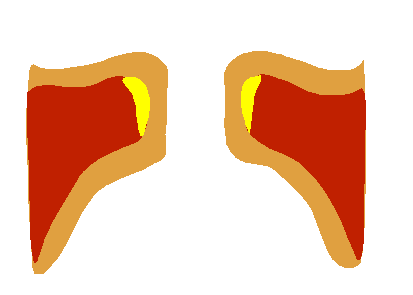Phonation
The folds are pushed apart by this increased sub-glottal pressure. Oscillate
The physics of the vocal cords can be modeled my a rubber band, stretched at two ends, attached to a blown-up balloon. If one presses on the balloon, the force of the air pressure will overcome the elastic force of the rubber band, allowing some air to escape from the rubber band. However, as the air escapes the air pressure will drop and the stretched rubber band will close again temporarily until the person pressing on balloon creates enough pressure to overcome the elastic force of the rubber band once more. The repetition of this cycle creates a sound.
When this occurs sufficiently fast, the rubber band will effectively be bouncing of itself. This is a good way to think about the vocal cords. When vocal cords are bouncing of each other cleanly a clear sound is produces. When the bounce is scuffed a dissonant sound results.
The vocal cords at one end are attached together to the same bone. However, the other ends are attached different bones that move freely in the transverse plane. A lateral movement of these ends of the vocal cords while phonating, will cause a greater amount of air will escape resulting in a breathy voice. A posterior movement of the free ends will stretch out the vocal cords, and the greater tension cause the vocal cords to oscillate faster resulting in a higher pitch. People with thicker and longer vocal cords will have deeper voices as their vocal cords cannot oscillating as fast.
The vocal cords bounce of each other in a rolling motion. The large variation in types of contact produces the large variation of tones that can be produced with the voice.

 Speech School
Speech School